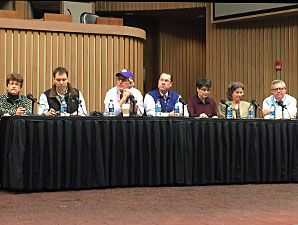Breeders' Cup Enhances Security, Testing


Breeders' Cup has again expanded its welfare, safety, and integrity protocol for this year's World Championships—with a big assist from host track Keeneland.
The decision to house all Breeders' Cup horses in barns at Keeneland's Rice Road annex, which includes two quarantine barns, has facilitated surveillance and made it easier for veterinarians to monitor horses, officials said Oct. 28 during a safety briefing. With the exception of horses in quarantine, most are spread out around the barn area at host tracks.
"It's the best possible scenario for security," said Dora Delgado, senior vice president of racing and nominations for Breeders' Cup. "There are nine barns and all the trainers are concentrated in one place."
Each barn has eight high-definition cameras for a total of 72. Along with security personnel, trainers have access to the feeds to monitor their horses.
"The pictures coming out of these cameras are fantastic," Delgado said.
Regular security personnel will be assisted by members of the National Guard. Breeders' Cup also has seven equine investigators that will work in conjunction with Kentucky Horse Racing Commission staff.
On a regular racing day in Kentucky, there are six full-time vets; for Breeders' Cup there will be up to 13, said Dr. Will Farmer, chief vet for the KHRC. The vets, who handle pre-race exams, also monitor horses each day in the lead up to the Breeders' Cup.
"We started last Saturday examining horses to help us build a history on these horses," Farmer said. "We've had three teams of vets in the barn area and two teams on the track so that any issues that arise are able to be dealt with quickly."
Breeders' Cup provided tablets so the vets can enter information into the InCompass database on all horses so their records are readily available for inspection.
Dr. Deborah Lamparter, chief veterinarian for the New Jersey Racing Commission, said there is a six-member veterinary panel charged with examining all Breeders' Cup entrants. The vets have traveled to Churchill Downs, the Trackside Training Center in Louisville, and other Kentucky training centers as well to inspect horses.
"With over 170 horses, you can imagine we've been very busy," Lamparter said. "As of today, we've seen every horse at least one time in the stable area."
In another change, Breeders' Cup altered its out-of-competition testing program so it begins much earlier rather than the customary two weeks out. Breeders' Cup president and chief executive officer Craig Fravel said the move was necessary because "the most effective testing is done on a surprise basis."
KHRC equine medical director Dr. Mary Scollay said about 43% of the Breeders' Cup entrants have been tested at various times this year in North America and Europe. She said the KHRC was awaiting the results of about a half-dozen other samples.
"Everything else has been cleared by the lab," Scollay said. "The medication load carried by the tested horses is strikingly low, which gives me confidence."
Testing is performed by LGS Science in Lexington and its affiliated lab in England. Scollay noted that the KHRC sampled "farm more horses" that may not have made the Breeders' Cup but were expected to do so.
"The testing can be an inconvenience but the cooperation has been exceptional," Fravel said. "I'm particularly pleased when I hear the words 'strikingly low.' We're dealing with elite horses here and they have a low level of medication administration."
